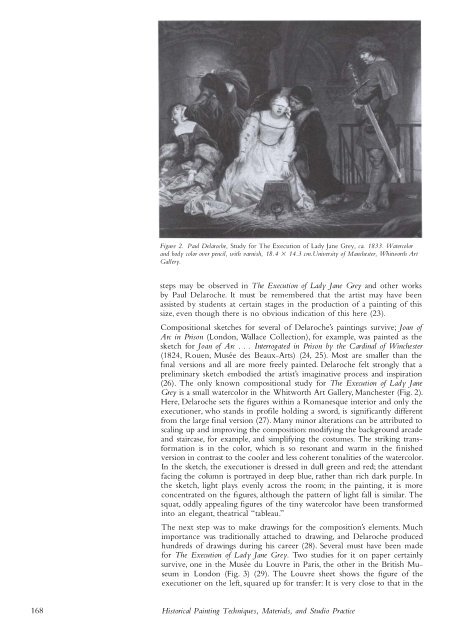Historical Painting Techniques, Materials, and Studio Practice
You also want an ePaper? Increase the reach of your titles
YUMPU automatically turns print PDFs into web optimized ePapers that Google loves.
Figure 2. Paul Delaroche, Study for The Execution of Lady Jane Grey, ca. 1833. Watercolor<br />
<strong>and</strong> body color over pencil, with varnish, 18.4 X 14.3 em. University of Manchester, f;IIhitworth Art<br />
Gallery.<br />
steps may be observed in The Execution if Lady Jane Grey <strong>and</strong> other works<br />
by Paul Delaroche. It must be remembered that the artist may have been<br />
assisted by students at certain stages in the production of a painting of this<br />
size, even though there is no obvious indication of this here (23).<br />
Compositional sketches for several of Delaroche's paintings survive; Joan of<br />
Arc in Prison (London, Wallace Collection), for example, was painted as the<br />
sketch fo r Joan if Arc . . . Interrogated in Prison by the Cardinal of Winchester<br />
(1824, Rouen, Musee des Beaux-Arts) (24, 25). Most are smaller than the<br />
fmal versions <strong>and</strong> all are more freely painted. Delaroche felt strongly that a<br />
preliminary sketch embodied the artist's imaginative process <strong>and</strong> inspiration<br />
(26). The only known compositional study for The Execution if Lady Jane<br />
Grey is a small watercolor in the Whitworth Art Gallery, Manchester (Fig. 2).<br />
Here, Delaroche sets the figures within a Romanesque interior <strong>and</strong> only the<br />
executioner, who st<strong>and</strong>s in profile holding a sword, is significantly different<br />
from the large final version (27). Many minor alterations can be attributed to<br />
scaling up <strong>and</strong> improving the composition: modifYing the background arcade<br />
<strong>and</strong> staircase, for example, <strong>and</strong> simplifYing the costumes. The striking transformation<br />
is in the color, which is so resonant <strong>and</strong> warm in the finished<br />
version in contrast to the cooler <strong>and</strong> less coherent tonalities of the watercolor.<br />
In the sketch, the executioner is dressed in dull green <strong>and</strong> red; the attendant<br />
facing the column is portrayed in deep blue, rather than rich dark purple. In<br />
the sketch, light plays evenly across the room; in the painting, it is more<br />
concentrated on the figures, although the pattern of light fall is similar. The<br />
squat, oddly appealing figures of the tiny watercolor have been transformed<br />
into an elegant, theatrical "tableau."<br />
The next step was to make drawings for the composition's elements. Much<br />
importance was traditionally attached to drawing, <strong>and</strong> Delaroche produced<br />
hundreds of drawings during his career (28). Several must have been made<br />
for The Execution if Lady Jane Grey. Two studies for it on paper certainly<br />
survive, one in the Musee du Louvre in Paris, the other in the British Museum<br />
in London (Fig. 3) (29). The Louvre sheet shows the figure of the<br />
executioner on the left, squared up fo r transfer: It is very close to that in the<br />
168<br />
<strong>Historical</strong> <strong>Painting</strong> <strong>Techniques</strong>, <strong>Materials</strong>, <strong>and</strong> <strong>Studio</strong> <strong>Practice</strong>


